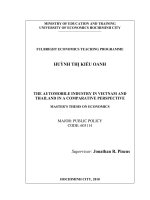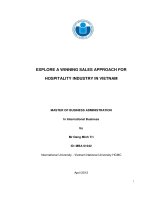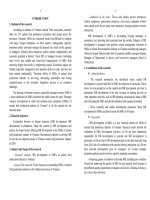E-COMMERCE INDUSTRY IN VIETNAM 2018
Bạn đang xem bản rút gọn của tài liệu. Xem và tải ngay bản đầy đủ của tài liệu tại đây (3.43 MB, 46 trang )
E-COMMERCE
INDUSTRY
IN VIETNAM
Edition 2018
Source: negativespace.co
RESEARCH REPORT
This project is co-funded
by the European Union
USEFUL CONTACTS
MORE INFORMATION
EU-Vietnam Business Network (EVBN)
15th Floor, 5B Ton Duc Thang, District 1
Ho Chi Minh City, Vietnam
T: +84 (0)28 38239515
www.evbn.org
General Statistics Office of Vietnam:
Vietnam Customs Statistics:
/>Vietnam Trade Promotion Agency (Vietrade):
en.vietrade.gov.vn
World Bank Vietnam:
/>
The Landmark, 15th floor, 5B Ton Duc Thang St., District 1,
Ho Chi Minh City, Vietnam
Tel. +84 (0)28 3823 9515 Fax +84 (0)28 3823 9514
www.evbn.org
This publication was produced with the assistance of the European
Union.
The content of this publication is the sole responsibility of EVBN and
can in no way be taken to reflect the views of the European Union.
EVBN E-commerce industry in Vietnam
2
CONTENTS
Contents
3
List of Abbreviations
4
Dominance of social media
28
Currency Exchange
4
B2C E-commerce landscape
List of Figures
5
Executive Summary
Case Studies
6
29
30
32
Chapter 4: Profile of End Consumer
34
Chapter 1: Vietnam Overview
Geo-demographics
8
Vietnam’s Economy
10
12
Structure of consumption expenditures
Chapter 2: Overview of E-commerce
in Vietnam
Vietnam’s digital landscape
B2C E-commerce
Overview of B2C E-commerce
Structure of B2C E-commerce
Payment methods
Logistics
B2B E-commerce
Service E-commerce
14
15
15
16
18
18
19
20
Market trends
Market drivers
21
Market barriers
Opportunities and challenges within
the E-commerce industry
25
Chapter 3: Competitive Landscape
B2B E-commerce landscape
Chapter 5: Regulatory and Legal
Framework
Regulatory and legal framework for
investors in the E-commerce industry
38
Relevance and impact of the EVFTA
40
Summary
41
List of Trade Fairs and Exhibitions
42
Main Online and Printed Publications
43
Useful Contacts
44
References
45
24
26
EVBN E-commerce industry in Vietnam
3
LIST OF ABBREVIATIONS
ASEAN
Association of Southeast Asian Nations
B2C
Business to Consumer
B2B
Business to Business
C2C
Consumer to Consumer
CAGR
CIT
COD
EU
EVFTA
Compound annual growth rate
Corporate Income Tax
Cash-on-delivery
European Union
EU-Vietnam Free Trade Agreement
FDI
Foreign Direct Investment
FOE
Foreign Owned Enterprise
FTA
Free Trade Agreement
GDP
Gross Domestic Product
GRDI
IOT
MoIT
Global Retail Development Index
Internet of Things
Ministry of Industry and Trade
POS
Point-of-Sale
SME
Small and Medium Enterprise
VCUFTA
Vietnam and Customs Union of
Belarus – Kazakhstan – Russia Free Trade Agreement
VECOM
Vietnam E-commerce Association
VECITA
Vietnam E-commerce and Information Technology Agency
VJEPA
Vietnam Japan Economic Partnership Agreement
VKFTA
Vietnam Korea Free Trade Agreement
WTO
World Trade Organization
CURRENCY EXCHANGE
EUR/US$
EUR/VND
0.81
27,998.64
EVBN E-commerce industry in Vietnam
4
LIST OF FIGURES
Figure 1: Map of Vietnam with key cities
8
Figure 2: Vietnam’s population 2013-20f
9
Figure 3: Forecast of rural and urban population in Vietnam and Asia Pacific, 2030
9
Figure 4: Nominal GDP and Real GDP growth, 2013-20f
10
Figure 5: Nominal GDP per capita, 2013-20f
10
Figure 6: Total registered FDI capital, 2010-2017
11
Figure 7: Total registered FDI capital by provinces, 2017
11
Figure 8: Structure of consumption expenditure, 2013-22f
12
Figure 9: Vietnamese Internet Users
14
Figure 10: Smartphone penetration rates in Vietnam
14
Figure 11:Structure of retail market in Vietnam
15
Figure 12: Vietnam B2C E-commerce market size and its proportion in total retail industry value, 2013-20f
16
Figure 13: Definitions of types of E-commerce
16
Figure 14: Number of registered E-commerce websites in Vietnam by type, 2015-2016
17
Figure 15: Preferred payment methods in Vietnam, 2015-2016
18
Figure 16: Estimated E-commerce logistics market value, 2018-2022f
18
Figure 17: Modes of shipping used by E-commerce businesses in 2016
19
Figure 18: Estimated market size of B2B E-commerce in Vietnam, 2012-2015
19
Figure 19: Growth in E-commerce website access via mobile phone in Southeast Asia
21
Figure 20: Percentage of online purchase methods in Vietnam, 2013 – 2016
22
Figure 21: Online shopping platform preferred by consumers, 2017
28
Figure 22: Top 10 E-commerce websites by monthly visits
29
Figure 23: List of some B2B E-commerce players in Vietnam
30
Figure 24: Tiki’s homepage and logo
32
Figure 25: Auchan’s homepage and logo
33
Figure 26: Online shopping frequency
35
Figure 27: Device used to shop online
36
Figure 28: Products/services most purchased online
36
Figure 29: E-commerce registration process
38
Figure 30: Conditions for opening a shop on some key: E-marketplaces in Vietnam
39
EVBN E-commerce industry in Vietnam
5
Executive
Summary
Vietnam is a land of opportunity for foreign E-commerce companies because of its
young population, high Internet penetration rate (ranked 17th in the world) and climbing
smartphone penetration rates. Millennials, considered the target population of
E-commerce firms, account for 30% of Vietnam’s population (approximately 30 million
people). The penetration of Internet is projected to increase steadily, with the percentage
of Internet users set to reach 65% in 2022.
Internet services made their first appearance in Vietnam in 1997. Three years later,
however, the Internet usage rate was still insignificant with a 0.2% local penetration.
However, the situation changed drastically over the years. In 2017, approximately 50
million Vietnamese, or half of the population, were connected to the Internet. Despite its
late start, Vietnam’s penetration rate (54%) in 2017 is now higher than the world average
(46.5%).
Following its accession to the WTO in 2007, Vietnam has allowed foreign investors to
establish 100% foreign-owned companies. This has attracted many foreign investors,
including E-commerce retailers. As E-commerce is expected to soon become an
important part of Vietnam’s trade sector, currently, big names such as Lazada, Shopee
(Sea Limited) and more recently, Amazon, market have seized the opportunity and
entered Vietnam. In 2017, the Southeast Asian E-commerce market was growing at 35%
per year, 2.5 times faster than in Japan. Vietnam ranks 4th for online shopping in the Asia
Pacific region and is expected to continue booming in the coming years, with sales
estimated to reach EUR8.1 billion in 2020.
This report will discuss the opportunities and challenges of E-commerce in Vietnam in
the next 5 years, with a focus on the B2B and B2C sectors. The report will also discuss the
impact of the EU-Vietnam Free Trade Agreement (EVFTA) on this market.
CHAPTER 1
VIETNAM OVERVIEW
Geo-demographics
Vietnam’s Economy
Structure of consumption expenditures
I. Geo-demographics
Vietnam comprises a landmass of 330,972.4 km2,
a vast sea area including a large continental
shelf and a string of archipelagos stretching
from the Gulf of Tonkin in the North to the Gulf
of Thailand in the South. In 2017, Vietnam’s
population was 95.54 million people and is
projected to reach 98.4 million in 2020, an
increase of 1% on average between 2015-2020.
Nha Trang
Ho Chi Minh City
Can Tho
Figure 1: Map of Vietnam with key cities
Image from www.wikipedia.org
Da Nang
Major cities in Vietnam, namely Hanoi, Hai
Phong, Danang, Nha Trang, Ho Chi Minh City,
and Can Tho, are well-dispersed geographically.
Hanoi, the capital of Vietnam, is the second
largest city in Vietnam and is the country’s
political and administrative centre. Hanoi is
known for its rich culture characterised by South
East Asian, Chinese and French influences. Ho
Chi Minh City, commonly known as Saigon, is
the country’s largest city and the commercial
hub of Vietnam. By 2030, Ho Chi Minh City will
continue to be the largest city in Vietnam by
population with over 10 million inhabitants
accounting for 23% of Vietnam’s total urban
population.
Image from www.vietnamtourism.gov.vn
Hanoi
EVBN E-commerce industry in Vietnam
8
*Unit: million people
91.50
92.54
93.57
94.57
95.54
96.49
97.43
98.36
2013
2014
2015
2016e
2017f
2018f
2019f
2020f
Figure 2: Vietnam's population 2013-20f
57%
RURAL
Vietnam
43%
URBAN
44%
RURAL
Asia
Pacific
56%
URBAN
Source: D&B
Although Vietnam remains predominantly
rural, it is expected to undergo significant
urbanisation in the next 14 years. By
2030, the urban population is forecasted
to increase by 37% from 2017, reaching
45.66 million people, or 43% of the
total population of Vietnam. This rapid
urbanisation is caused predominantly
by the growth of urban cities and the
expansion of the urban-based industrial
and services sectors. Moreover, high
urbanisation rate causes a pressure on
the construction sector to increase the
number of high-rise apartment buildings
and office buildings.
Figure 3: Forecast of rural and urban
population in Vietnam and
Asia Pacific, 2030
Source:UNDP
EVBN E-commerce industry in Vietnam
9
II. Vietnam’s Economy
Gross Domestic Product
250
8
6.7
6.0
5.4
6.2
6.7
7
6
150
100
50
128.4
140.0
172.5
193.9
182.0
228.6
208.1
248.8
5
4
(%)
(€ bn)
200
6.8
3
2
1
0
2013
2014
2015
2016
2017
Nominal GDP (EUR bn)
2018e
2019f
2020f
0
Real GDP growth (%)
Figure 4: Nominal GDP and Real GDP growth, 2013-20f
Source: BMI
Real gross domestic product (GDP) growth is expected to accelerate at 6.7% in 2018, reaching €208.1
billion in value. With this growth rate, Vietnam remains one of the fastest-growing economies in Asia. The
solid increase pace is foreseen to continue until 2020, to reach €248.8 billion. The outlook is underpinned
by ongoing Government policies regarding the privatisation of state-owned enterprises (SOEs), the
maintenance of price stability, the lowering of trade barriers and reduced tax rates.
3000
2500
(€)
2000
1500
1,843
1,403
1,924
2,029
2,156
2,346
2,529
1,512
1000
500
0
2013
2014
2015
2016
2017
2018e
2019f
2020f
In 2017, Vietnam’s nominal GDP
per capita reached €2,029, an
increase of 5.4% compared to
2016. Nonetheless, the country has
been recognised for its effort to
increase the GDP per capita, and
expects to reach a GDP per capita
of €2,529 in 2020. A solid increase
in GDP per capita suggests that an
average Vietnamese will have more
disposable income to spend on
more goods than just basic needs.
Figure 5: Nominal GDP per capita, 2013-20f
Source: BMI
EVBN E-commerce industry in Vietnam 10
Foreign Direct Investment
(€ mn)
24,041
17,577
15,066
11,904
2010
2011
18,436
19,761
16,378
10,530
2012
2013
2014
2015
2016
2017
In 2017, Vietnam received a
record €24 billion of foreign
direct investment (FDI). This is a
reflection of the increase in trade
and production in Vietnam as more
global manufacturing giants have
decided to move their production
facilities to Vietnam to reap the
benefits from the numerous
incentives to attract investments
from the government.
Figure 6: Total registered FDI
capital, 2010-2017
Source: GSO
Ho Chi Minh City, Vietnam’s commercial centre, continued to receive the most FDI in 2017 with a total
registered capital of nearly EUR 2.7 billion. Provinces such as Binh Duong and Bac Ninh, where LG and
Samsung established their manufacturing centres, also received large amounts of FDI at EUR 2.0 and EUR 2.6
billion, respectively. Thanh Hoa and Khanh Hoa are two provinces receiving the highest number of newly
registered capital, respectively, due to mega Build – Operate – Transfer Japan’s thermal power projects.
Ho Chi Minh City
2,684.4
Bac Ninh
2,640.6
Thanh Hoa
2,563.8
Khanh Hoa
Binh Duong
(Unit: EUR mn)
2,104.7
2,003.5
Other
12,054.1
Figure 7: Total registered FDI capital by provinces, 2017
Source: GSO
EVBN E-commerce industry in Vietnam 11
III. Structure of consumption expenditures
With this GDP growth and increase in disposable income, consumption expenditure is expected to grow
at a rate of 9% during 2016-22f. The increase in the standard of living will likely also raise the price and the
quality of goods purchased by Vietnamese consumers.
6,000
EUR per year per household
5,000
4,000
3,000
2,000
1,000
0
Other
Leisure & education
Transport & communications
Health spending
Furnishing and home
Housing and utilities
Clothing & footwear
Food, beverages & tobacco
2013 2014
624
212
515
69
149
396
74
588
669
228
551
74
160
422
80
629
2015
715
244
588
79
171
450
85
671
2016 2017
754
258
618
84
180
472
90
706
815
279
667
91
195
508
97
761
2018
2019
2020
2021
2022
883
303
721
98
211
548
105
823
967
332
787
108
231
598
114
899
1,060
365
862
118
253
653
125
984
1,163
401
944
130
277
714
137
1,078
1,278
441
1,035
143
305
782
151
1,183
Figure 8: Structure of consumption expenditure, 2013-22f
Source: BMI
EVBN E-commerce industry in Vietnam 12
Source: negativespace.co
CHAPTER 2
OVERVIEW OF
E-COMMERCE IN VIETNAM
Vietnam’s digital landscape
Market trends
Market drivers
Market barriers
Opportunities and challenges within the E-commerce industry
I. Vietnam’s digital landscape
Vietnam first connected to the Internet in November
1997. In the last 20 years, the country has seen a
tremendous increase in the number of Internet
users. According to the Minister of Information
and Communications, Vietnam had approximately
52 million Internet users in 2017, or a 54% Internet
penetration rate, which is above the global
average of 46.5%. This puts Vietnam at the top of
Asian countries and the numbers are expected to
continue rising at a fast pace, thanks to relatively
flexible bandwidths services and low cellular data
cost. With the increasing accessibility to the Internet,
more and more people will have the opportunity to
access and use E-commerce services.
60
Unit: million users
CAGR 12-17: 10.9%
52.0
50
40
31.0
30
20
17.0
10
0
0.2
1997
2007
2012
2017
Figure 9: Vietnamese Internet Users
Source: Ministry of Information and Communications
80%
72%
72%
2016
2017
70%
60%
55%
50%
40%
36%
30%
20%
10%
20%
2013
2014
2015
This rise of Internet adoption can
be partly attributed to the country’s
high smartphone penetration
rate. In the past five years, the
country has witnessed a surge in
smartphone ownership, thanks
to smartphones’ popularity and
the rise of Vietnam’s per capita
disposable income. According to
2017 statistics from Google, nearly
72% of the Vietnamese population
use a smartphone. As smartphones
are key to conduct E-commerce
activities online, the rise of
smartphone ownership will have a
profound effect on the E-commerce
landscape.
Figure 10: Smartphone penetration rates in Vietnam
Source: Google Consumer Barometer
EVBN E-commerce industry in Vietnam 14
1.
B2C E-commerce
As mentioned in the 2018 EVBN Vietnam Retail Market Study, the retail industry in Vietnam comprises three
main channels: traditional, modern and online. This report will be dedicated to the study of the online
retail channel, or B2C E-commerce, with a brief overview of the emerging B2B E-commerce channel.
R E T A I L
I N D U S T R Y
TRADITIONAL
RETAIL
Wet
markets
Grocery
stores
MODERN
RETAIL
ONLINE
RETAIL
Hypermarkets Department stores/ Convenience
Supermarkets Shopping Centres Specialty Stores
E-commerce
Figure 11: Structure of retail market in Vietnam
Source: Speeda
1.1. Overview of B2C E-commerce
E-commerce is defined in Decree 52/2013/ND-CP
as follows:
“E-commerce activity means conducting part or
the whole of the process of commercial activity
by electronic means connected to the Internet,
mobile telecommunications network or other
open networks.”
Vietnam currently has one of the fastest growing
B2C E-commerce markets in Southeast Asia, with a
32.3% CAGR from 2013-17, translating to a market
size of EUR 5.5 billion in 2017. The E-commerce
industry in Vietnam is forecasted to continue
rising rapidly with a forecasted CAGR of 14%
during 2017-20f, accounting for 5.2% of total retail
sales. Though the E-commerce’s market share is
still relatively small, with its digitally savvy young
population, (i.e., Millennials, born between 1981
and 1996; and Generation Z, born between 1997
and 2010) and a high smartphone penetration,
Vietnam’s transition from brick-and-mortar to
online retail seems inevitable.
EVBN E-commerce industry in Vietnam 15
150
148.8
(Unit: EUR bn)
120
90
89.1
80.6
72.0
60
30
70.2
1.8
0
2013
140.7
2.4
2014
104.9
95.6
85.9
78.2
110.4
99.6
3.3
2015
4.1
2016
E-commerce
5.5
8.1
2017
2020f
Modern & Traditional Retail
Figure 12: Vietnam B2C E-commerce market size and its proportion in total retail industry value, 2013-20f
Source: VECOM, GSO, Ipsos Business Consulting analysis
Aware of this opportunity, numerous companies, both domestic and international, have invested
significantly to get the first-mover advantage. Their presence has made the landscape dynamic and
competitive, especially in the absence of a clear market leader. The competitive landscape and profile of
key players are further discussed in the Competitive Landscape section below.
1.2. Structure of B2C E-commerce
According to Decree 52/2013/ND-CP, B2C E-commerce in Vietnam is classified into four different types:
E-commerce trading floor
(E-marketplace)
E-commerce website
(E-commerce sales website)
“An E-commerce website permitting traders,
organizations or individuals that are not the
website owners to conduct a portion or the
whole process of buying and selling goods
and services on that website, excluding
online securities trading websites.”
“The electronic information page set to
serve a portion or the whole process of
buying and selling activities of goods or
provision of services, from display and
introduction of goods or services to
entering to contract, service provision,
payment and after-sales service.”
B2C
Online promotion website
Online auction website
“An E-commerce website providing solutions
allowing traders, organizations and
individual that is not the website owners to
auction their goods on that website.”
“An E-commerce website set up by traders
and organizations to promote the goods
and services of traders, organizations or
individuals under the terms and conditions
of a promotion service contract.”
Figure 13: Definitions of types of E-commerce
Source: Decree No.52/2013/ND-CP
EVBN E-commerce industry in Vietnam 16
E-commerce websites constitute the majority of E-commerce activities in Vietnam, although
e-marketplaces are gaining popularity. Online auction sites and online promotion sites remain a
significant part in the E-commerce landscape.
15,000
13,510
12,000
9,000
9,429
6,000
3,000
0
2016
2017
E-commerce
sales website
492
682
2016
2017
E-marketplace
19
20
19
93
2016
2017
2016
2017
Online auction
sites
Online promotion
sites
Figure 14: Number of registered E-commerce websites in Vietnam by type, 2015-2016
Source: Vietnam E-commerce Report 2017 by VECITA
Vietnamese consumers are shopping online through two other means: social media platforms and
mobile apps. While social media platforms are quite popular among Vietnamese consumers, mobile
commerce is still an emerging trend. These two means are further discussed in the Market trend and
Competitive landscape sections below:
SOCIAL NETWORK
MOBILE APPLICATION
is “an information system providing its users with
services such as storage, provision, use, search,
sharing, and exchange of information, including the
provision of personal websites, forum, online chats,
audio and video sharing, and other similar devices.”
indicates “an application installed on mobile
equipment connected to a network that allows users
to access the databases of traders, organizations
and individuals to purchase and sell goods and
provide or use services. Mobile applications include
goods sale applications and e-commerce service
provision applications.”
(Decree 72/2013)
(Circular 59/2015)
EVBN E-commerce industry in Vietnam 17
1.3. Payment methods
Compared to the E-commerce industry,
the E-commerce payment landscape
lags behind considerably. Credit card
usage remains low in Vietnam, and cashon-delivery (COD) continues to be the
preferred method of payment. E-wallets
are not doing any better with their waning
popularity. Despite a recent rise in credit
card usage, it is unlikely that consumers’
behaviour will change in the near future.
Lack of trust is a significant barrier to the
adoption of online payment methods.
100
91% 89%
80
60
48%
41%
40
20%
20
11%
Figure 15:
Preferred payment methods
in Vietnam, 2015-2016
Source: Vietnam E-commerce Report 2017 by VECITA
5%
0
2015 2016
2015 2016
2015 2016
Cash on
delivery
Bank
transfer
Electronic
wallet
23%
6% 7%
2015 2016
2015 2016
Mobile/game Credit/debit
cards
cards
1.4. Logistics
Logistics and delivery are a constant challenge
for the E-commerce industry in Vietnam due
to slow transportation (e.g., a truck cargo from
Ho Chi Minh City to Hanoi can take up to three
days) and the preference for COD payments. The
combination of a booming E-commerce industry
and an underdeveloped logistics infrastructure has
motivated firms to invest considerably in this field,
leading to an impressive forecasted y-o-y growth of
42% during 2018-22f.
1000
This E-commerce gold rush has resulted in a crowded
and competitive logistics landscape with over 50
providers as of 2017, from traditional express services
(e.g., Viettel, EMS, and VNPost) to start-ups (e.g.,
giaohangnhanh, supership, and giaohangtietkiem)
and international players (e.g., DHL eCommerce,
Grab Express, and Lazada Express).
0
(Unit: EUR million)
CAGR 18-22: 42.1%
801.9
800
600
464.3
400
268.8
200
90.1
2018e
155.7
2019f
2020f
2021f
2022f
Figure 16:
Estimated E-commerce
logistics market value, 2018-2022f
Source: Ken Research, Ipsos Business Consulting analysis
EVBN E-commerce industry in Vietnam 18
10%
45%
45%
Fulfill orders themselves
Hire a third party
With COD as the preferred method of payment, it
is crucial for E-commerce businesses to establish a
reliable shipping and delivery network. While large
companies often have a dedicated logistics and
delivery department responsible for fulfilling orders
(for example, Lazada is the first E-commerce company
in Vietnam to have its own delivery company named
LEX – Lazada Express), the majority of companies use
third-party services. Small businesses and individual
shops rely on third-party providers and freelance
shippers to minimise operational capital.
Figure 17:
Modes of shipping used by E-commerce
businesses in 2016
Source: VECITA
Both
2.
B2B E-commerce
Business-to-business (B2B) E-commerce remains
relatively new in Vietnam, yet it receives much
attention and support from the government. In
recent years, the government has taken actions to
respond to the rise and development of the B2B
E-commerce industry.
and Amazon has announced that it would offer
E-commerce services to the Vietnam E-commerce
Association (VECOM), a group consisting of 140 local
businesses, to sell and export their products.
1.2
CAGR 12-15: 22.9%
E-Commerce in Vietnam falls under the umbrella of
import-export activities, based on the assumption
that E-commerce is a time and cost efficient channel
for cross-border trade, especially for SMEs with limited
financial resources. In 2016, 32% of businesses in
Vietnam partnered with foreign companies through
online channels.
Vietnam is a member of many economic
communities and has joined several free trade
agreements (FTAs) including the Vietnam-Korea FTA
(VKFTA), the Vietnam-Japan Economic Partnership
Agreement (VJEPA), the Vietnam-Eurasian Economic
Union (VCUFTA), and the European-Vietnam FTA
(EVFTA), which will come into effect in 2018. With the
support of these FTAs, B2B E-commerce is expected
to grow considerably in the near future. Vietnam’s
lucrative market has captured the attention of
international players: Alibaba now allows 500 to
600 Vietnamese exporters to sell on its platform,
1.0
Unit: EUR billion
0.8
0.6
1.05
0.86
0.4
0.70
0.57
0.2
0.0
2012
2013
2014
2015
Figure 18: Estimated market size of B2B
E-commerce in Vietnam, 2012-2015
Source: eMarketer
EVBN E-commerce industry in Vietnam 19
3.
Service E-commerce
E-commerce is also a potential channel for services such as online tourism, online entertainment, online gaming
to online education services.
Online tourism in Vietnam is still in its infancy. But as Vietnam becomes a more lucrative destination, demand
is expected to increase. According to the VECOM, the rate of room reservations via online travel agents have a
y-o-y growth of over 30%, up from 20% in 2016. However, the market is currently dominated by foreign players
such as Agoda and Booking, which collectively hold about 80% of the market share. These websites are widely
popular among domestic and foreign travellers alike.
Due to the rising Internet penetration in Vietnam, online entertainment (movie tickets, event tickets) have
been rising steadily, accounting for a small but increasingly significant share of the total E-commerce value. This
emerging market is dominated by foreign players such as CGV for movie tickets and Ticketbox for event tickets.
However, it is expected to become more dynamic as more players enter the market. But with Vietnam’s low
credit card usage, it is unclear whether or when online entertainment will take off.
Vietnam’s online gaming market is one of the largest in Southeast Asia with more than a third of its population
playing online games, for a total of approximately EUR295 million in 2017. However, 80% of those games are
imported from South Korea and China, and none of the most popular games are Vietnamese.
Although online education (E-learning) has arrived in Vietnam a decade ago, it has taken off only recently.
In 2015, the country’s E-learning market size was estimated at EUR40.5 million only. However, according to
Ambient Insight, the country has a forecasted y-o-y growth rate of 44% on average in 2013-2018. As of August
2017, there were approximately 150 online education start-ups, which can be segmented into three groups:
Foreign languages: ESL dominates the market, but Japanese, Chinese and Korean language courses are
on the rise. Examples: tienganh123.com and tiengnhatonline.edu.vn
Preparation for the National University Entrance Exam: includes courses in mathematics, physics,
literature, chemistry and biology. Example: hocmai.vn
IT and soft skills: Vietnamese have started to pay more attention to these to improve their careers.
Example: kyna.vn
While e-services are undoubtedly promising in Vietnam, they are still in their early stages. Moreover, their study
is complicated by the fact that they are generally treated under their respective service category rather than
under the E-commerce umbrella. For this reason, e-services will not be further discussed in this report.
EVBN E-commerce industry in Vietnam 20
II. Market trends
Continuous increase in mobile shopping
iPrice recorded that in 2017, 72% of E-commerce
websites in Southeast Asia were accessed from a
mobile device. However, conversion rates – the
percentage of website visits that convert into a
product purchase – were 1.7 times higher from a
computer than from a mobile device. In Vietnam,
the year 2015 was characterised by a boom in
mobile commerce after E-commerce operators
made substantial investments in creating mobilefriendly versions of their websites. Nonetheless,
only 15% of E-commerce operators had mobile
websites in 2017.
80%
Although mobile commerce has not yielded
great returns for operators yet, it deserves serious
consideration in the future, especially amidst
rising cellular network subscription (3G and 4G)
and higher smartphone penetration.
50%
72%
70%
70%
62%
60%
57%
2016 | Q3
2016 | Q4
2017 | Q1
2017 | Q2
Figure 19:
Growth in E-commerce website access
via mobile phone in Southeast Asia
Source: iPrice
E-marketplaces are gaining popularity
Vietnam’s E-commerce landscape has seen the emergence of several e-marketplaces such as Sendo
(sendo.vn), Adayroi (adayroi.vn), Shopee (shopee.vn) and Tiki (tiki.vn). According to a survey of 1,159
Vietnamese Internet users by the Vietnam E-Commerce and Information Technology Agency (VECITA),
e-marketplaces are gaining popularity. Users reporting having used e-marketplace websites have risen
from 19% in 2013 to 41% of respondents in 2017. Usage of E-commerce websites rose from 57% to 76%
respectively, while usage of group-buying websites – a kind of online promotion website – went down
from 51% to 24% in the same period. It should be noted that although the number of E-commerce
websites grows faster than that of e-marketplace websites, they are generally the online version of their
brick-and-mortar retail outlets. Therefore, their popularity may not be as high as it seems.
EVBN E-commerce industry in Vietnam 21
E-marketplaces, defined as “websites for parties other than the website owner to conduct trade of
their goods and services,” ease the buying and selling process between organizations and individuals,
thus facilitating online C2C trade. With e-marketplace websites on a rapid rise, Vietnam’s E-commerce
landscape can expect changes.
80
70
60
50
76%
71%
61%
57%
51%
35%
40
28%
30
20
10
19%
2013
E-commerce websites
25%
27%
2014
2015
E-marketplace
41%
24%
2016
Group-buying websites
Figure 20: Percentage of online purchase methods in Vietnam, 2013 – 2016
Source: VECITA
E-commerce logistics sets to robust
E-commerce logistics services facilitate the delivery of products and real-time communication of
information about customers’ orders. Those services support the flow of goods through the transaction
cycle, from order to check-out, packing, delivery, payment tracking, and post-sales services.
The significant investments in E-commerce logistics is expected to further boost the growth of the
E-commerce industry. New players are entering the market, and established E-commerce operators are
expanding their business into the logistics segment. Giao Hang Nhanh Company aims to have 1,500
outlets by 2018, whereas DHL eCommerce is looking to add 1,000 outlets to its current nationwide
network of service points in Vietnam by the end of 2019.
But the race is not just about expanding presence; it is also about innovation. Giao Hang Nhanh Company
plans to create a network of collection points at local shops, convenience stores and in buildings. Lazada,
on the other hand, runs automated sorting centres in Ho Chi Minh City and Hanoi.
As long as E-commerce continues to grow at its current pace, the E-commerce logistics industry will
continue to improve. There are opportunities, more particularly, to develop better last-mile delivery, i.e.,
the stage where goods are delivered to the buyer.
Photo by Fancycrave from Pexels
EVBN E-commerce industry in Vietnam 22
Cross-border E-commerce
is expected to grow big
The number of Vietnamese accounts on Alibaba was 500,000 in 2016, with 100,000 additional accounts
every year since then. Vietnamese buyers consume foreign goods and services in larger numbers than
foreign buyers consume goods and services from Vietnam. According to the Vietnam E-Commerce
Association, this trend can be explained by three factors. First, foreign goods are more varied and more likely
to meet domestic customers’ needs. Second, Vietnamese E-commerce websites are generally distrusted
while reputable names such as Amazon, Alibaba and Rakuten, are perceived as more trustworthy. Finally,
shipping from overseas to Vietnam is less costly than the other way around.
Several actions have been taken to facilitate E-commerce to and from Vietnam. Amazon have partnered
with VECOM to provide training for Vietnamese sellers on how to efficiently sell on Amazon. Moreover, the
Ministry of Industry and Trade has proposed various policies favourable to E-commerce in the hope that
it will boost cross-border E-commerce between Vietnam and other countries.
EVBN E-commerce industry in Vietnam 23
Source: freepik.com
III. Market drivers
1. Growth in young population
The coming of age of Generation Z,
accounting for 16% of the population, or 14
million people in 2017, is expected to boost
Vietnam’s E-commerce market in the next five
years. This generation, who will have never
known a world without the Internet, will have
started using mobile devices at a young age.
Millennials, representing 30% of the population
(approximately 29 million people in 2017), are
currently the largest group of online shoppers
in Vietnam. They are characterised by their
changing lifestyle and willingness to pay more
to improve their lives.
2. Rising income
Vietnam has witnessed the fastest-growing
middle and affluent class compared to other
ASEAN countries. Between 2012 and 2020, this
consumer segment will rise from 12 million to
33 million. The new middle class has already
fulfilled its basic and low-end needs and is now
willing to pay more for impact and high-end
shopping. This economic growth is favourable
to the expansion of E-commerce in terms of
both quantity and quality.
3. Growing retail market
Vietnam’s retail market is considered a top
priority market with low market saturation. The
nation was ranked sixth in the Global Retail
Development Index (GRDI), an increase of five
ranks compared to the previous year. While
remaining a small market in terms of size,
Vietnam exhibits great potential for foreign
competitors looking to enter the market.
With a growing retail market coupled with a
high adoption of technology, the acceleration
of the E-commerce industry is obvious and
opportunities for businesses are vast.
4. Government initiatives
The government’s Decision No. 1563 has
approved a master plan to foster E-commerce
over the period from 2016 to 2020. The
government considers E-commerce essential to
help Vietnamese businesses boost the domestic
and export markets, join the global value chain,
and enhance the national competitiveness for
global integration.
The key elements of this plan include:
Bolstering the efficiency
administrative services;
of
government
Ensuring 30% of the population buy goods and
services online;
Ensuring an average spend of EUR283.5 per
person online;
Increasing revenue from online B2C to EUR8.1 billion;
Ensuring B2B revenue accounts for 5% of total
retail spend;
Ensuring online B2B turnover is worth 30% of
total turnover in 2020.
In order to achieve these targets, the
Vietnamese government is planning to develop
a comprehensive legal framework for all
E-commerce activities. A national E-commerce
payment system and integrated e-payment
solutions applicable to all E-commerce models
will be established by 2020. Transportation as
well as delivery service networks and orderprocessing systems will be implemented
EVBN E-commerce industry in Vietnam 24
in all cities and provinces nationwide. The
government will also formulate mechanisms
for the settlement of disputes and handling
of violations in the E-commerce environment.
Finally, to facilitate online shopping and
e-payment, point-of-sale (POS) terminals
will be installed in all retail outlets, including
department stores, supermarkets and modern
distribution centres. Finally, 70% of electricity,
water, telecoms and media service providers
will support the e-payment of service charges.
5. Digital transformation
The last force driving Vietnam’s E-commerce
market is the digital transformation, which refers
to the emergence of new technologies such as
analytics, mobility, social media and more recently,
the Internet of Things (IOT). The rise of the Internet
and other information technologies has helped
Vietnamese people adopt online shopping. The
spread of digital technology to all aspects of
human society will make this trend continue.
IV. Market barriers
1. Lack of trust
Lack of trust remains the greatest hindrance to
the growth of E-commerce in Vietnam. It applies
to various aspects of a transaction, from product
quality to customer service, data protection,
banking fraud, unfulfilled deliveries, etc. This
lack of trust stems from an immature market
and the lack of technological infrastructure in
the country.
2. Predominant of COD
payment method
Despite its growing E-commerce market, the
e-payment ecosystem in Vietnam is rather
inadequate. Vietnam is still a cash-based society
and Vietnamese consumers generally distrust
financial institutions when it comes to securing,
saving and transferring their money. For that
reason, credit cards and online banking are
not widely used. Moreover, many consumers
see credit card and online banking transaction
fees as unnecessary costs. Such fees may
also discourage large transactions. From the
perspective of E-commerce operators, COD
leads to higher cancellation rates and lower
profitability. Thus, this cultural preference will
continue to hamper the growth of Vietnam’s
E-commerce industry.
3. Underdeveloped logistics and
delivery facilities
Vietnam requires a better logistics infrastructure
to support the growth of its E-commerce industry.
Oftentimes, third-party logistics providers and
E-commerce websites have to work together to
meet the demand of the frequent, small-sized
orders of Vietnamese consumers. Moreover,
E-commerce in Vietnam depends on a high
number of reliable shippers, since shippers
not only deliver the product to customers but
also collect payment. Therefore, most market
players use a combination of in-house delivery
teams and third-party service providers. Online
sellers, regardless of their size, tend to opt for
outsourced delivery services, either partly or
fully, for the distribution of a large number of
packages simultaneously. Further investment
in logistics technology and infrastructure is still
required to address current problems such as
failed deliveries and high-costs.
EVBN E-commerce industry in Vietnam 25









